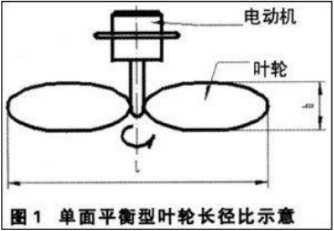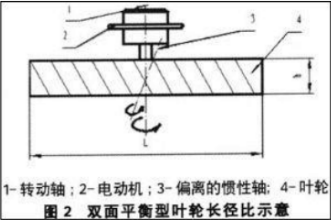Range hoods, electric fans, exhaust fans, bathroom heaters, and even air conditioners are all fan type household appliances that rely on the high-speed rotation of the impeller to drive the rapid flow of air in order to achieve their work objectives.
Serious attention has always been paid to the dynamic balance problem of the impeller of the range hood. When disassembling and measuring the structures of various range hoods, special attention is paid to the structural characteristics of the impeller of the range hood. When inspecting range hood manufacturers in Zhejiang, Jiangsu, Guangdong, and other regions, it is intentional to specifically understand the control level of each manufacturer on the dynamic balance problem of the impeller. Therefore, it is observed that some manufacturers are actually using the method of dealing with the dynamic balance problem of single-sided balance machine impellers to deal with the dynamic balance problem of double-sided balance machine impellers.
In fact, this issue is very easy to detect: if it is confirmed that the impeller belongs to a double-sided dynamic balancing machine, at least two balancing plates should be observed on the impeller; If the impeller belongs to a double-sided dynamic balancing machine and only one balancing plate is observed, it can be considered that its dynamic balancing treatment of the impeller is inappropriate.
According to the ratio of the diameter of the fan impeller to the width of the impeller disc, which is also known as the "length to diameter ratio", the impeller can be divided into "single-sided dynamic balancing machine" impeller and "double-sided dynamic balancing machine" impeller.
When the diameter of the impeller is 7-10 times larger than the width of the impeller (i.e. the thickness of the impeller side projection), i.e. the aspect ratio is greater than l/10-1/7, it belongs to a single-sided dynamic balancing machine impeller. Electric fans, exhaust fans, etc. all belong to this type. In this case, if the impeller is found to have dynamic imbalance problems, it is only necessary to install an equivalent torque correction mass on any part of the diameter where the impeller center of mass is located, which can restore the center of mass of the deviated impeller to the axis position and keep the impeller in a balanced state (see Figure 1).

For impellers with a length to diameter ratio less than 1/10~1/7, the above method is not applicable. Impellers with a length to diameter ratio less than 1/10~1/7 belong to "double-sided balancing machine" impellers. On the impeller of a double-sided balancing machine, when the impeller is in an unpowered driving state, if two equal masses are arranged at both ends of the axis and the axis is symmetrical, the center of mass of the impeller does not show any deviation from the rotation axis of the impeller, and the impeller is actually in a state of "static balance"; But once the impeller enters a high-speed rotating state, the centrifugal forces generated by these two masses each form a couple, and the inertia axis and rotation axis of the impeller no longer coincide, resulting in strong vibration of the impeller bearings; Alternatively, if the two masses are also asymmetric and the inertia axis and rotation axis are inclined, the center of mass of the impeller will deviate from the axis, and the vibration of the impeller during rotation will significantly increase. This is the most common dynamic imbalance phenomenon in the impeller of a double-sided dynamic balancing machine. To eliminate this dynamic imbalance state of the impeller, it is necessary to install correction masses on at least two planes (see Figure 2).

In addition, the impeller of fan type household appliances is generally a "cantilever" rotor structure, which only has support at one end of the connection between the impeller and the motor spindle. The impeller is in a suspended state, which can be regarded as a "cantilever beam" structure in structural mechanics. This cannot be ignored when analyzing the dynamic balance of oil fume (see Figure 2).
After knowing the classification method of the dynamic balance types of the impeller, one can make a judgment on the dynamic balance type of the range hood impeller. The range hood impeller belongs to the cantilever double-sided dynamic balance machine impeller. In the process of designing, manufacturing, installing, applying, and maintaining a range hood, it is crucial to have a clear understanding of the types and characteristics of the dynamic balance of the range hood impeller.
Based on the data collected on the impellers of range hoods, it is believed that most of the impellers used in current range hood production should belong to cantilever double-sided dynamic balancing machine impellers.
From the various range hood impellers dismantled and measured by technicians, it can be seen that at present, the diameter of range hood impellers is usually around 200mm (190mm for slightly smaller ones and 220mm for slightly larger ones). According to the division method of "single-sided balancing machine" impellers and "double-sided balancing machine" impellers, if the impeller diameter is 210mm, the width of the impeller (due to the centrifugal impeller commonly used in range hoods, its width state is very obvious from the side view) should be between 21-30mm; That is to say, when the width of the impeller of the range hood is not greater than 30mm, the impeller with a diameter of 210mm can be balanced on one side to balance the center of mass of the impeller, ensuring that the range hood will not experience abnormal vibration due to the dynamic balance state of the impeller during high-speed operation.
Serious attention has always been paid to the dynamic balance problem of the impeller of the range hood. When disassembling and measuring the structures of various range hoods, special attention is paid to the structural characteristics of the impeller of the range hood. When inspecting range hood manufacturers in Zhejiang, Jiangsu, Guangdong, and other regions, it is intentional to specifically understand the control level of each manufacturer on the dynamic balance problem of the impeller. Therefore, it is observed that some manufacturers are actually using the method of dealing with the dynamic balance problem of single-sided balance machine impellers to deal with the dynamic balance problem of double-sided balance machine impellers.
In fact, this issue is very easy to detect: if it is confirmed that the impeller belongs to a double-sided dynamic balancing machine, at least two balancing plates should be observed on the impeller; If the impeller belongs to a double-sided dynamic balancing machine and only one balancing plate is observed, it can be considered that its dynamic balancing treatment of the impeller is inappropriate.
According to the ratio of the diameter of the fan impeller to the width of the impeller disc, which is also known as the "length to diameter ratio", the impeller can be divided into "single-sided dynamic balancing machine" impeller and "double-sided dynamic balancing machine" impeller.
When the diameter of the impeller is 7-10 times larger than the width of the impeller (i.e. the thickness of the impeller side projection), i.e. the aspect ratio is greater than l/10-1/7, it belongs to a single-sided dynamic balancing machine impeller. Electric fans, exhaust fans, etc. all belong to this type. In this case, if the impeller is found to have dynamic imbalance problems, it is only necessary to install an equivalent torque correction mass on any part of the diameter where the impeller center of mass is located, which can restore the center of mass of the deviated impeller to the axis position and keep the impeller in a balanced state (see Figure 1).

For impellers with a length to diameter ratio less than 1/10~1/7, the above method is not applicable. Impellers with a length to diameter ratio less than 1/10~1/7 belong to "double-sided balancing machine" impellers. On the impeller of a double-sided balancing machine, when the impeller is in an unpowered driving state, if two equal masses are arranged at both ends of the axis and the axis is symmetrical, the center of mass of the impeller does not show any deviation from the rotation axis of the impeller, and the impeller is actually in a state of "static balance"; But once the impeller enters a high-speed rotating state, the centrifugal forces generated by these two masses each form a couple, and the inertia axis and rotation axis of the impeller no longer coincide, resulting in strong vibration of the impeller bearings; Alternatively, if the two masses are also asymmetric and the inertia axis and rotation axis are inclined, the center of mass of the impeller will deviate from the axis, and the vibration of the impeller during rotation will significantly increase. This is the most common dynamic imbalance phenomenon in the impeller of a double-sided dynamic balancing machine. To eliminate this dynamic imbalance state of the impeller, it is necessary to install correction masses on at least two planes (see Figure 2).

In addition, the impeller of fan type household appliances is generally a "cantilever" rotor structure, which only has support at one end of the connection between the impeller and the motor spindle. The impeller is in a suspended state, which can be regarded as a "cantilever beam" structure in structural mechanics. This cannot be ignored when analyzing the dynamic balance of oil fume (see Figure 2).
After knowing the classification method of the dynamic balance types of the impeller, one can make a judgment on the dynamic balance type of the range hood impeller. The range hood impeller belongs to the cantilever double-sided dynamic balance machine impeller. In the process of designing, manufacturing, installing, applying, and maintaining a range hood, it is crucial to have a clear understanding of the types and characteristics of the dynamic balance of the range hood impeller.
Based on the data collected on the impellers of range hoods, it is believed that most of the impellers used in current range hood production should belong to cantilever double-sided dynamic balancing machine impellers.
From the various range hood impellers dismantled and measured by technicians, it can be seen that at present, the diameter of range hood impellers is usually around 200mm (190mm for slightly smaller ones and 220mm for slightly larger ones). According to the division method of "single-sided balancing machine" impellers and "double-sided balancing machine" impellers, if the impeller diameter is 210mm, the width of the impeller (due to the centrifugal impeller commonly used in range hoods, its width state is very obvious from the side view) should be between 21-30mm; That is to say, when the width of the impeller of the range hood is not greater than 30mm, the impeller with a diameter of 210mm can be balanced on one side to balance the center of mass of the impeller, ensuring that the range hood will not experience abnormal vibration due to the dynamic balance state of the impeller during high-speed operation.
161 browse
